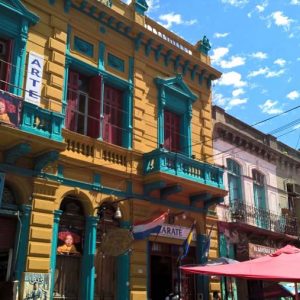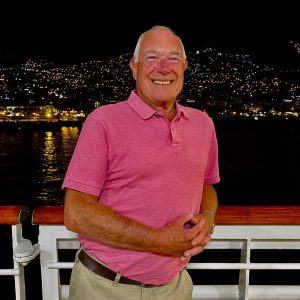Ever dreamed of building your own home in a favourite spot? I did just that and has lived to tell the tale (just). The building process spanned almost ten years but the result is stunning.
I was young, impressionable and totally bowled over.
That was the start of a love affair that continues unabated to this day. Like all love affairs we’ve had our ups and downs; I’ve stormed off occasionally – in fact quite a few times – but, with a few more grey hairs we got through it and I’m more in love with Shieldaig and the wild, west Highland coast than ever. Particularly now our lovely Highland home is finished, though it took almost ten years of heartache, stress, spiraling costs and litigation to get there. But like all the best things in life, you usually have to go through some pain. And, boy, we certainly did that.
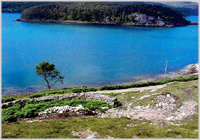 I was 19 the first year I visited Shieldaig and, at that time, it took almost two days to drive up from Lancashire. My husband’s ancestors were from the area and throughout his childhood the family would visit for the long summer holidays. Before the coastal road to Applecross was built in 1972 he used to help out on the weekly provision boat taking food and mail to the outlying hamlets on the peninsula. As soon as I arrived I understood why this was his most favourite place in the world. It was like nowhere else I had visited in the UK and to this day remains a place of majestic beauty and wildness some 40+ years later.
I was 19 the first year I visited Shieldaig and, at that time, it took almost two days to drive up from Lancashire. My husband’s ancestors were from the area and throughout his childhood the family would visit for the long summer holidays. Before the coastal road to Applecross was built in 1972 he used to help out on the weekly provision boat taking food and mail to the outlying hamlets on the peninsula. As soon as I arrived I understood why this was his most favourite place in the world. It was like nowhere else I had visited in the UK and to this day remains a place of majestic beauty and wildness some 40+ years later.
It was always my husband’s dream that one day he would build his own house in Shieldaig that all the family could enjoy. So when his mother gifted him a piece of land she had bought in the ‘60s we couldn’t have been more delighted. The site known locally as An Cos – Gaelic for the hollow – sits in an elevated position overlooking the loch and island, the picturesque fishing cottages of Shieldaig and, on a clear day, the isle of Harris on the far horizon. The land nestles into the rock behind a large dry stone wall which is over two hundred years old, originally built to shelter livestock from the elements.
We knew building on the remote west coast of Scotland was going to be a challenge (nearest town Inverness 1½ hours away) but had no idea how stressful and expensive the whole process was going to be. If you are reading this with a view to building your own home in a remote idyll, perhaps best look away now.
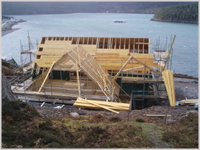 With the help of an Inverness based architect we designed a traditional style house better suited to our needs than the original design for which planning permission had been given in the 60s, but for various reasons the family did not commence building works. Luckily, though, my husband had the foresight to lay a foundation cornerstone to ensure the planning permission would be extent, otherwise, as events turned out, we would not have been able to build at all.
With the help of an Inverness based architect we designed a traditional style house better suited to our needs than the original design for which planning permission had been given in the 60s, but for various reasons the family did not commence building works. Luckily, though, my husband had the foresight to lay a foundation cornerstone to ensure the planning permission would be extent, otherwise, as events turned out, we would not have been able to build at all.
As our revised plans were only a variation to an existing consent we thought this would be a fairly straight-forward process. That was our first mistake.
Although many of the locals were supportive, there were a small number who objected. A petition in the local shop encouraged anyone passing through to add their name, so to our great surprise we had objections from people in Texas and other far-flung places. Some objections were on religious grounds as the site had been used for open-air worship following the dissolution of the Church of Scotland and confirmation services were held on the site as recently as the 1950s. Despite the fact the church had given their blessing to build before the land was purchased, and the planning permission was still extent, we had to have an on-site meeting with the Highland council planning committee and local councillors, objectors, our very expensive solicitor from Edinburgh and, of course, the press!
Eventually planning permission was duly given so we thought we were home and dry. However, one of the objectors approached Historic Scotland who duly slapped a preservation order on the land, which meant we would never be able to build. Back to the lawyer in Edinburgh, who definitely earned his crust, because it transpired Historic Scotland were unaware of the planning permission and he was eventually successful in getting the order over-turned.
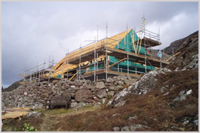 It had taken three years to get to this stage, but we were now ready to build.
It had taken three years to get to this stage, but we were now ready to build.
Our architect approached around 20 companies as far afield as the Outer Hebrides and southern Scotland over the course of the next few years, but all were booked up – some for five years -because of a building boom on the East coast. By now, in danger of losing our hard-won planning permission variation, there was no alternative: we had to build the house ourselves and contract in all the trades individually. Not a decision we took lightly, particularly living in London, but we had no option.
Without going into all the traumatic details of the build itself – it can still bring on palpitations – it took over five years from start to finish. During this time we had a procession of trades from Scotland, England and Poland; some let us down badly, others were brilliant. When our project management team from central Scotland walked off site half way through the build because they hadn’t experienced, and couldn’t cope with, the extreme west coast conditions and lack of available tradesmen, it fell to us to pick up the pieces. In a particularly freezing December with just over 6 hours of daylight, no electricity or workers on site, and no mobile contact, I was more than ready to throw in the towel and walk away myself.
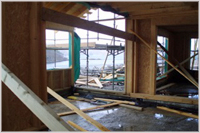 During the intervening years we managed the project from London and were usually on site every month, which was not always easy. I drove several long-wheel base vans filled to the brim with fittings, including a roll-top bath and furniture, from London, as choice is extremely limited in the Highlands and many companies do not deliver this far north. En route I scoured antique shops for special pieces and sourced local artists to start decorating the blank walls. I also found a wonderful craftsman who made most of our oak furniture as well as an excellent curtain maker and upholsterer who helped transform our house into a home.
During the intervening years we managed the project from London and were usually on site every month, which was not always easy. I drove several long-wheel base vans filled to the brim with fittings, including a roll-top bath and furniture, from London, as choice is extremely limited in the Highlands and many companies do not deliver this far north. En route I scoured antique shops for special pieces and sourced local artists to start decorating the blank walls. I also found a wonderful craftsman who made most of our oak furniture as well as an excellent curtain maker and upholsterer who helped transform our house into a home.
Our final challenge was the garden. We planted hundreds of Scots pine saplings and some semi-mature trees over three years ago, but growth is slow and our site is particularly exposed. But a small price to pay for breathtaking views.
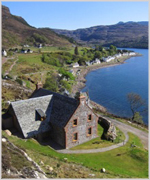 If the weather isn’t kind we can sit inside and, from the comfort of the house, watch the weather patterns ‘weave’ across the loch, curl up in front of a roaring log fire with a fine malt in hand, and, like childbirth, the trauma of the build is a very distant memory. Though, unlike childbirth I’m not sure we would do it again!
If the weather isn’t kind we can sit inside and, from the comfort of the house, watch the weather patterns ‘weave’ across the loch, curl up in front of a roaring log fire with a fine malt in hand, and, like childbirth, the trauma of the build is a very distant memory. Though, unlike childbirth I’m not sure we would do it again!
We spend as much time in Shieldaig as possible and, as we get older, intend to spend even more time there. Essentially, An Cos is our family home that will be passed down for generations to come but, when not being used, it is occasionally available to rent.
For full details visit www.AnCosShieldaig.co.uk
or contact me, Chrissy@silvertravel.co.uk or enquiries@AnCosShieldaig.co.uk


